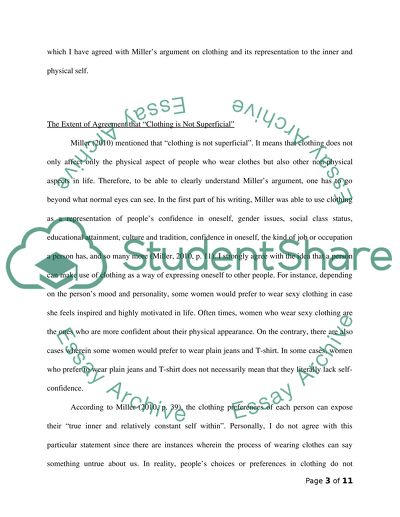Cite this document
(“Referring to specific examples of clothing in your answer, explain why Essay”, n.d.)
Referring to specific examples of clothing in your answer, explain why Essay. Retrieved from https://studentshare.org/miscellaneous/1679616-referring-to-specific-examples-of-clothing-in-your-answer-explain-why-daniel-miller-argues-that-clothing-is-not-superficial-miller-d-2010-stuff-cambridge-polity-p-11-to-what-extent-do-you-agree-with-his-argument
Referring to specific examples of clothing in your answer, explain why Essay. Retrieved from https://studentshare.org/miscellaneous/1679616-referring-to-specific-examples-of-clothing-in-your-answer-explain-why-daniel-miller-argues-that-clothing-is-not-superficial-miller-d-2010-stuff-cambridge-polity-p-11-to-what-extent-do-you-agree-with-his-argument
(Referring to Specific Examples of Clothing in Your Answer, Explain Why Essay)
Referring to Specific Examples of Clothing in Your Answer, Explain Why Essay. https://studentshare.org/miscellaneous/1679616-referring-to-specific-examples-of-clothing-in-your-answer-explain-why-daniel-miller-argues-that-clothing-is-not-superficial-miller-d-2010-stuff-cambridge-polity-p-11-to-what-extent-do-you-agree-with-his-argument.
Referring to Specific Examples of Clothing in Your Answer, Explain Why Essay. https://studentshare.org/miscellaneous/1679616-referring-to-specific-examples-of-clothing-in-your-answer-explain-why-daniel-miller-argues-that-clothing-is-not-superficial-miller-d-2010-stuff-cambridge-polity-p-11-to-what-extent-do-you-agree-with-his-argument.
“Referring to Specific Examples of Clothing in Your Answer, Explain Why Essay”, n.d. https://studentshare.org/miscellaneous/1679616-referring-to-specific-examples-of-clothing-in-your-answer-explain-why-daniel-miller-argues-that-clothing-is-not-superficial-miller-d-2010-stuff-cambridge-polity-p-11-to-what-extent-do-you-agree-with-his-argument.


